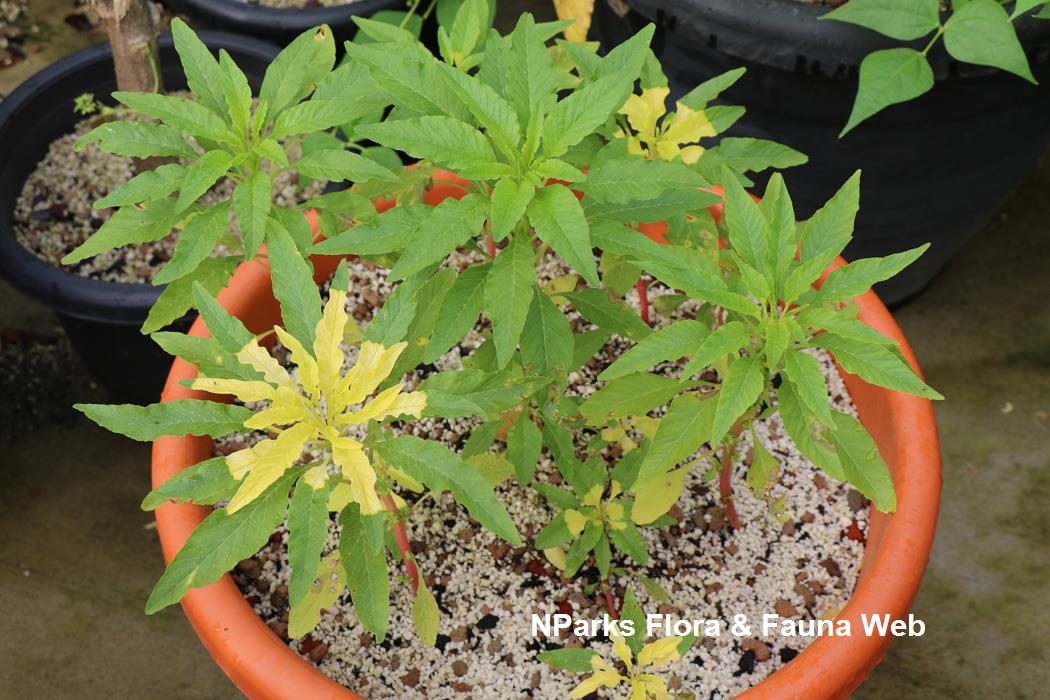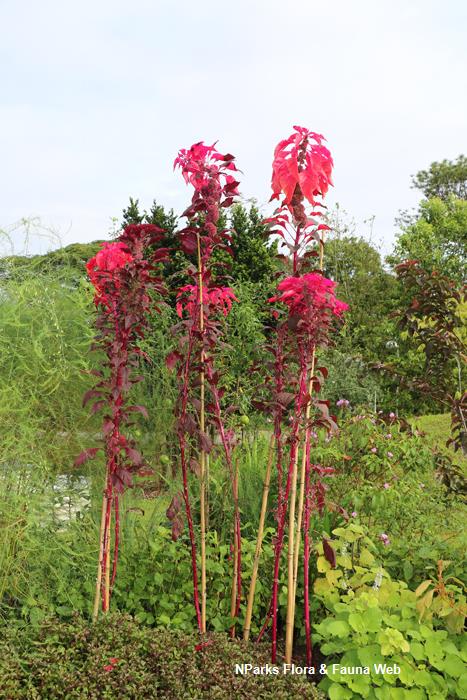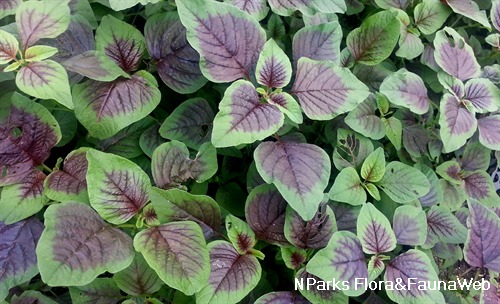
Name
Classifications and Characteristics
| Plant Division | Angiosperms (Flowering Seed Plants) (Dicotyledon) |
|---|---|
| Plant Growth Form | Herbaceous Plant |
| Lifespan (in Singapore) | Annual |
| Mode of Nutrition | Autotrophic |
| Plant Shape | Vase |
| Maximum Height | 0.5 m to 1 m |
Biogeography
| Native Distribution | Pantropical |
|---|---|
| Native Habitat | Terrestrial |
| Preferred Climate Zone | Tropical |
| Local Conservation Status | Of Uncertain Origin |
Description and Ethnobotany
| Growth Form | An annual herbaceous plant with erect growth habit, can grow up to 1 m tall. |
|---|---|
| Foliage | Leaves glabrous, petiolate; blade ovate, rhomboid or ovate-elliptic shaped; measuring 3 - 9 cm in length and 3 - 6 cm in width; base obtuse, apex emarginate; margin entire to sinuate. Cultivars have varying patterns of yellow, red and green foliage. |
| Stems | Stem slender, herbaceous, sparingly branched. |
| Flowers | This species is monoecious, having separate male and female flowers on the same plant. Small, greenish flowers are borne in a radial pattern along a spike inflorescence which is often branched. The flowers are wind-pollinated and can also self-pollinate. |
| Fruit | Seeds subglobose-shaped, dark brown to black, about 1 mm in diameter. |
| Similar | This species looks similar to other Amaranthus species, but its wrinkled fruits and pointed flower bracts (< 1 mm long) are distinctive. |
| Cultivation | Avoid feeding plants with too much nitrogen, as it may cause the plant nitrate content to become too high. Excessive consumption of nitrate may cause adverse health effects. |
| Etymology | The genus Amaranthus means unfading, which refers to the long-lasting flowers. |
Fauna, Pollination and Dispersal
| Fauna Pollination Dispersal Associated Fauna | Butterfly Host Plant, Caterpillar Moth Food Plant |
|---|
Plant Care and Propagation
| Light Preference | Full Sun |
|---|---|
| Water Preference | Lots of Water |
| Rootzone Tolerance | Moist Soils, Well-Drained Soils, Fertile Loamy Soils |
| Pest(s) | Chewing Insects, Sucking Insects |
| Propagation Method | Seed |
Foliar
| Foliage Retention | Evergreen |
|---|---|
| Mature Foliage Colour(s) | Green |
| Mature Foliage Texture(s) | Raised / Sunken Veins |
| Prominent Young Flush Colour(s) | Green |
| Young Flush Texture(s) | Smooth, Raised / Sunken Veins |
| Foliar Type | Simple / Unifoliate |
| Foliar Arrangement Along Stem | Alternate |
| Foliar Attachment to Stem | Petiolate |
| Foliar Shape(s) | Non-Palm Foliage (Ovate, Elliptical) |
| Foliar Venation | Pinnate / Net |
| Foliar Margin | Entire, Sinuate |
| Foliar Apex - Tip | Emarginate, Acute |
| Foliar Base | Rounded / Obtuse |
| Typical Foliar Area | Mesophyll ( 45cm2 - 182.25 cm2 ) |
| Leaf Area Index (LAI) for Green Plot Ratio | 4.5 (Shrub & Groundcover - Dicot) |
Non - Foliar and Storage
| Stem Type & Modification | Herbaceous |
|---|---|
| Root Type | Underground |
Floral (Angiosperm)
| Flower & Plant Sexuality | Unisexual Flowers |
| Flower Colour(s) | Green |
|---|---|
| Flower Grouping | Cluster / Inflorescence |
| Flower Location | Axillary |
| Inflorescence Type | Spike |
Fruit, Seed and Spore
| Mature Fruit Colour(s) | Black, Brown |
|---|---|
| Mature Fruit Texture(s) | Smooth |
| Fruit Classification | Simple Fruit |
| Fruit Type | |
| Mature Seed Colour(s) | Black, Brown |
| Mature Seed Texture(s) | Smooth, Glossy / Shiny |
Image Repository
Others
| Master ID | 31415 |
|---|---|
| Species ID | 5812 |
| Flora Disclaimer | The information in this website has been compiled from reliable sources, such as reference works on medicinal plants. It is not a substitute for medical advice or treatment and NParks does not purport to provide any medical advice. Readers should always consult his/her physician before using or consuming a plant for medicinal purposes. |







